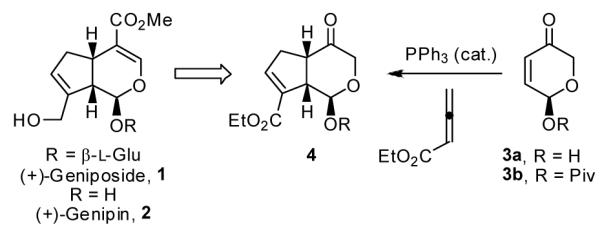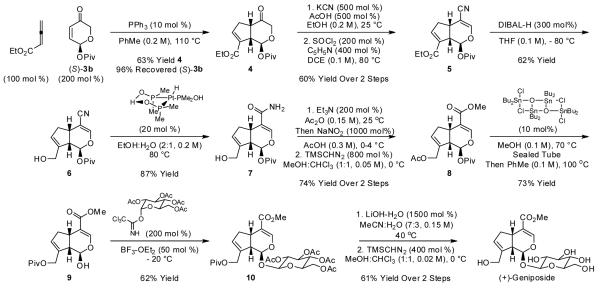Abstract
Phosphine catalyzed [3+2] cycloaddition of ethyl-2,3-butadienoate with enone (S)-3b occurs with high levels of regio- and stereocontrol to deliver the cis-fused cyclopenta[c]pyran 4 characteristic of the iridoid family of natural products. Cycloadduct 4 was converted to the iridoid glycoside (+)-geniposide in 10 steps.
The iridoids are a large family of monoterpenoid natural products structurally characterized by a highly oxygenated cis-fused cyclopenta[c]pyran ring system. 1 Members of this class embody a diverse range of biological activities,1d, 2 which has made them popular synthetic targets.3 Despite enormous progress, synthetic approaches to iridoid natural products that incorporate their natural β-glycosides remain rare due to difficulties associated with the glycosidation.4
In the course of our studies in the area of phosphine organocatalysis, 5, 6, 7, 8, 9 we explored intramolecular variants of Lu’s phosphine catalyzed [3+2] cycloaddition reported in 1995.5a, 10, 11, 12 Whereas the intermolecular cycloaddition generally provides mixtures of regio- and stereoisomeric adducts, the intramolecular cycloaddition delivers diquinanes in structurally homogenous form. As a regio- and stereocontrolled intermolecular cycloaddition of this type would be of great utility, we explored dipolarophiles possessing γ-heteroatom substitution, as in the case of enones 3, which are prepared conveniently through the Achmatowicz reaction of furfuryl alcohol. 13 It was postulated that such γ-heteroatom substitution should (a) activate the dipolarophile toward cycloaddition, (b) reinforce the inherent regiochemical bias, and (c) direct the diastereofacial selectivity of cycloaddition.
Here, we report that “Achmatowicz enones” 3 engage in regio- and stereocontrolled intermolecular [3+2] cycloaddition, thus providing direct access to the iridoid ring system 4. This methodology was applied to the synthesis of the iridoid glycoside (+)-geniposide 1,14 which displays antitumor15 and anti-inflammatory16 activity. The total asymmetric synthesis of (+)-geniposide 1 constitutes a formal synthesis of its aglycone (+)-genipin 2,17, 18 which recently has garnered attention as an effective treatment for type II diabetes (Scheme 1).19
Scheme 1.

Retrosynthetic analysis of (+)-geniposide 1 and (+)-genipin 2.
Exposure of commercially available furfuryl alcohol to m-CPBA in dichloromethane delivered lactol rac-3a in 78% yield,12 which was converted to the pivalate rac-3b in 80% yield. Kinetic resolution of rac-3b was attempted under the conditions of palladium catalyzed allylic substitution employing p-nitrobenzyl alcohol as nucleophile.20 After careful optimization, it was found that chirally modified palladium catalysts arising from the combination of [(η3-C3H5)PdCl]2 (1.0 mol %) and the parent Trost ligand (3 mol %) enable recovery of the allylic pivalate (S)-3b in 92% ee in a satisfactory 70% theoretical isolated yield. Optically pure (S)-3b is readily achieved upon recrystallization from pentane. The byproduct (R)-3c was isolated in 96% theoretical isolated yield in 68% ee. Absolute stereochemistry was determined by single crystal X-ray diffraction analysis of 4,5-dichlorophthalimide adduct of (S)-3b using the anomalous dispersion method, and is consistent with the stereochemical models developed by Trost for related kinetic resolutions (Scheme 2).21
Scheme 2.

Kinetic resolution of rac-3b using palladium catalyzed allylic substitution.
With (S)-3b in hand, the phosphine-catalyzed [3+2] cycloaddition was attempted using ethyl-2,3-butadienoate. Gratifyingly, using triphenylphosphine as catalyst (10 mol %) in toluene (0.2 M) at 110 °C, the desired cycloadduct 4 was obtained in 63% isolated yield after 30 minutes as a single regio- and stereoisomer, as confirmed by single crystal X-ray diffraction analysis. Note that while two equivalents of (S)-3b are used in the cycloaddition, unreacted (S)-3b was recovered in 96% isolated yield.
Installation of the α,β-unsaturated methyl ester was accomplished in a stepwise fashion. Cycloadduct 4 was converted to the cyanohydrin, which upon elimination furnished the α,β-unsaturated nitrile 5 in 60% isolated yield over two steps. Chemoselective reduction of the α,β-unsaturated ethyl ester of compound 5 using DIBAL-H delivered the allylic alcohol 6 in 62% yield. Further conversion of nitrile 6 to the methyl ester was made difficult due to the sensitivity of the enol moiety to acid, as well as the base sensitivity of the pivalate. Using the Ghaffer-Parkins catalyst, 22 hydration of nitrile 6 to the primary amide 7 was accomplished in 87% isolated yield. Nitrosation of amide 7 resulted in hydrolysis to furnish the carboxylic acid.23 During the course of this reaction the primary alcohol was converted to the acetate. Exposure of carboxylic acid to TMS-diazomethane delivered the methyl ester 8 in 74% yield over two steps.
To complete the synthesis of (+)-geniposide 1, installation of the β-glucoside was required. Quite serendipitously, it was found that upon exposure of methanolic solutions of compound 8 to Otera’s catalyst,24 acetate removal was accompanied by transfer of the pivaloyl moiety to provide lactol 9 in 73% yield as a 5:1 mixture of epimers at the anomeric carbon. Compound 9 was independently prepared from commercially available (+)-genipin 2, thus corroborating its structural assignment and providing a convenient source of forefront material. Glycosidation of lactol 9 employing the trichloroacetimidate as the glycosyl donor delivered the β-glucoside 10 in 62% yield as a single diastereomer. Global deprotection of 10 using aqueous lithium hydroxide in acetonitrile 25 provided (+)-geniposide 1 in 61% isolated yield, the spectral data of which corresponded to that of previously reported material.26
In summary, we report an asymmetric synthesis of the iridoid glucoside (+)-geniposide 1 in 14 steps. A key feature of our synthetic strategy involves rapid construction of the cis-fused cyclopenta[c]pyran iridoid ring system employing a phosphine catalyzed intermolecular [3+2] cycloaddition. Unlike typical intermolecular cycloadditions employing acrylates, fumarates and maleates, which provide adducts as mixtures of regio- and diastereoisomers, the unique structural features of γ-heteroatom substituted enones 3 combine high levels of reactivity with excellent regio- and stereocontrol.
Supplementary Material
Table 1.
Conversion of (S)-3b to (+)-geniposide 1 via phosphine catalyzed [3+2] cycloaddition.a

|
See supporting information for detailed experimental procedures.
Acknowledgments
Acknowledgment is made to the Robert A. Welch Foundation and NSF (CHE-0749016).
Footnotes
Supporting Information Available. Spectral data for all new compounds (1H NMR, 13C NMR, IR, HRMS). Single crystal X-ray diffraction data for the 4,5-dichlorophthalimide adduct of (S)-3a and the cycloadduct 4. This material is available free of charge via the internet at http://pubs.acs.org.
References
- (1).For reviews that catalog members of the iridoid family, see: El-Naggar LJ, Beal JL. J. Nat. Prod. 1980;43:649. doi: 10.1021/np50012a001. Boros CA, Stermitz FR. J. Nat. Prod. 1990;53:1055. Dinda B, Debnath S, Harigaya Y. Chem. Pharm. Bull. 2007;55:159. doi: 10.1248/cpb.55.159. Dinda B, Debnath S, Harigaya Y. Chem. Pharm. Bull. 2007;55:689. doi: 10.1248/cpb.55.689.
- (2).For reviews of the biological activity of iridoid natural products, see: Villaseñor IM. Anti-Infl. Anti-Allergy Agent Med. Chem. 2007;6:307. Tundis R, Loizzo MR, Menichini F, Statti GA, Menichini F. Mini-Rev. Med. Chem. 2008;8:399. doi: 10.2174/138955708783955926.
- (3).For reviews on the synthesis of iridoid natural products, see: Tietze L-F. Angew. Chem. Int. Ed. Engl. 1983;22:829. Bianco A. Stud. Nat. Prod. Chem. 1990;7:439. Bianco A. Pure Appl. Chem. 1994;66:2335. Isoe S. Stud. Nat. Prod. Chem. 1995;16:289. Nangia A, Prasuna G, Rao PB. Tetrahedron. 1997;53:14507. Franzyk H. Prog. Chem. Org. Nat. Prod. 2000;79:1.
- (4).For syntheses of iridoid glycosides see: Büchi G, Carlson JA, Powell JE, Tietze L-F. J. Am. Chem. Soc. 1970;92:2165. Partridge JJ, Chadha NK, Uskoković MR. J. Am. Chem. Soc. 1973;95:532. doi: 10.1021/ja00802a053. Büchi G, Carlson JA, Powell JE, Tietze L-F. J. Am. Chem. Soc. 1973;95:540. Tietze L-F. Angew. Chem. Int. Ed. Engl. 1973;12:757. Tietze L-F. Chem. Ber. 1974;107:2499. Tietze L-F, Fischer R, Remberg G. Liebigs Ann. Chem. 1987:971. Piccini P, Vidari G, Zanoni G. J. Am. Chem. Soc. 2004;126:5088. doi: 10.1021/ja0493796. Mangion IK, Macmillan DWC. J. Am. Chem. Soc. 2005;127:3696. doi: 10.1021/ja050064f.
- (5).For reviews on phosphine organocatalysis, see: Lu X, Zhang C, Xu Z. Acc. Chem. Res. 2001;34:535. doi: 10.1021/ar000253x. Methot JL, Roush WR. Adv. Synth. Catal. 2004;346:1035. Lu X, Du Y, Lu C. Pure Appl. Chem. 2005;77:1985. Ye L-W, Zhou J, Tang Y. Chem. Soc. Rev. 2008;37:1140. doi: 10.1039/b717758e. Kwong CK-W, Fu MY, Lam CS-L, Toy PH. Synthesis. 2008:2307.
- (6).For phosphine catalyzed cycloisomerization of electron deficient bisolefins, see: Wang L-C, Luiz A-L, Agapiou K, Jang H-Y, Krische MJ. J. Am. Chem. Soc. 2002;124:2402. doi: 10.1021/ja0121686. Agapiou K, Krische MJ. Org. Lett. 2003;5:1737. doi: 10.1021/ol030035e. Luis A-L, Krische MJ. Synthesis. 2004:2579. Frank SA, Mergott DJ, Roush WR. J. Am. Chem. Soc. 2002;124:2404. doi: 10.1021/ja017123j.
- (7).For phosphine catalyzed regioretentive allylic substitutions of Morita-Baylis-Hillman acetates, see: Cho C-W, Kong JR, Krische MJ. Org. Lett. 2004;6:1337. doi: 10.1021/ol049600j. Cho C-W, Krische MJ. Angew. Chem. Int. Ed. 2004;43:6689. doi: 10.1002/anie.200461381. Park H, Cho C-W, Krische MJ. J. Org. Chem. 2006;71:7892. doi: 10.1021/jo061218s. (d)For an asymmetric variant, see:
- (8).For phosphine catalyzed α-arylation of enones employing hypervalent bismuth reagents, see: Koech PK, Krische MJ. J. Am. Chem. Soc. 2004;126:5350. doi: 10.1021/ja048987i. Koech PK, Krische MJ. Tetrahedron. 2006;62:10594.
- (9).For merged Tsuji-Trost-Morita-Baylis-Hillman cyclizations of enoneallyl acetates, see: Jellerichs BG, Kong JR, Krische MJ. J. Am. Chem. Soc. 2003;125:7758. doi: 10.1021/ja0301469. Webber P, Krische MJ. J. Org. Chem. 2008;73:9379. doi: 10.1021/jo802165k.
- (10).For phophine catalyzed intramolecular [3+2] cycloaddition of acetylenic esters to enones, see: Wang JC, Ng SS, Krische MJ. J. Am. Chem. Soc. 2003;125:3682. doi: 10.1021/ja030022w. Wang J-C, Krische MJ. Angew. Chem. Int. Ed. 2003;42:5855. doi: 10.1002/anie.200352218.
- (11).For the seminal phosphine catalyzed [3+2] cycloaddition reported by Lu, see: Zhang C, Lu X. J. Org. Chem. 1995;60:2906. Xu Z, Lu X. Tetrahedron Lett. 1997;38:3461. Xu Z, Lu X. Tetrahedron Lett. 1999;40:549. Xu Z, Lu X. J. Org. Chem. 1998;63:5031. Du Y, Lu X, Yu Y. J. Org. Chem. 2002;67:8901. doi: 10.1021/jo026111t.
- (12).For related phosphine catalyzed cycloadditions, see: Xu Z, Lu X. Tetrahedron Lett. 1997;38:3461. Xu Z, Lu X. J. Org. Chem. 1998;63:5031. Zhu X-F, Lan J, Kwon O. J. Am. Chem. Soc. 2003;125:4716. doi: 10.1021/ja0344009. Zhu X-F, Schaffner A-P, Li RC, Kwon O. Org. Lett. 2005;7:2977. doi: 10.1021/ol050946j. Tran YS, Kwon O. J. Am. Chem. Soc. 2007;129:12632. doi: 10.1021/ja0752181. Henry CE, Kwon O. Org. Lett. 2007;9:3069. doi: 10.1021/ol071181d. Creech GS, Kwon O. Org. Lett. 2008;10:429. doi: 10.1021/ol702462w.
- (13) (a).Achmatowicz O, Jr., Bukowski P, Szechner B, Zwierzchowska Z, Zamojski A. Tetrahedron. 1971;27:1973. [Google Scholar]; (b) Lefebvre Y. Tetrahedron Lett. 1972;2:133. [Google Scholar]
- (14).For the isolation of (+)-geniposide, see: Inouye H, Saito S. Tetrahedron Lett. 1969;28:2347.
- (15) (a).Ueda S, Iwahashi Y, Tokuda H. J. Nat. Prod. 1991;54:1677. doi: 10.1021/np50078a032. [DOI] [PubMed] [Google Scholar]; (b) Lee M-J, Hsu J-D, Wang C-J. Anticancer Res. 1995;15:411. [PubMed] [Google Scholar]
- (16).Koo H-J, Lim K-H, Jung H-J, Park E-H. J. Ethnopharmacol. 2006;103:496. doi: 10.1016/j.jep.2005.08.011. [DOI] [PubMed] [Google Scholar]
- (17).For the isolation of (+)-genipin, see: Djerassi C, Gray JD, Kincl FA. J. Org. Chem. 1960;25:2174.
- (18).For the conversion of (+)-geniposide to its aglycone (+)-genipin, see: Endo T, Taguchi H. Chem. Pharm. Bull. 1973;21:2684. doi: 10.1248/cpb.22.1935. Tanaka M, Kigawa M, Mitsuhashi H, Wakamatsu T. Heterocycles. 1991;32:1451. (c)
- (19).Zhang C-Y, Parton LE, Ye CP, Krauss S, Shen R, Lin C-T, Porco JA, Lowell BB. Cell Metab. 2006;3:417. doi: 10.1016/j.cmet.2006.04.010. [DOI] [PubMed] [Google Scholar]
- (20).For related allylic alkylations, see: van der Deen H, van Oeveren A, Kellogg RM, Feringa BL. Tetrahedron Lett. 1999;40:1755. Comely AC, Eelkema R, Minnaard AJ, Feringa BL. J. Am. Chem. Soc. 2003;125:8714. doi: 10.1021/ja0347538. Babu RS, O’Doherty GA. J. Am. Chem. Soc. 2003;125:12406. doi: 10.1021/ja037097k. Babu RS, Zhou M, O’Doherty GA. J. Am. Chem. Soc. 2004;126:3428. doi: 10.1021/ja039400n. Trost BM, Toste FD. J. Am. Chem. Soc. 2003;125:3090. doi: 10.1021/ja020988s.
- (21).Trost BM, Machacek MR, Aponick A. Acc. Chem. Res. 2006;39:747. doi: 10.1021/ar040063c. [DOI] [PubMed] [Google Scholar]
- (22) (a).Parkins AW, Ghaffer T. Tetrahedron Lett. 1995;47:8657. [Google Scholar]; (b) Ghaffer T, Parkins A. J. Mol. Catal. A. 2000;160:249. [Google Scholar]
- (23).Lin R, Castells J, Rapoport H. J. Org. Chem. 1998;63:4069. [Google Scholar]
- (24).Otera J, Dan-oh N, Hitosi N. J. Org. Chem. 1991;56:5307. [Google Scholar]
- (25).Mouriès C, Deguin B, Koch M, Tillequin F. Helv. Chim. Acta. 2003;86:147. [Google Scholar]
- (26) (a).Güvenalp Z, Kiliç N, Kazaz C, Kaya Y, Demirezer Ö. Turk. J. Chem. 2006;30:515. [Google Scholar]; (b) Morota T, Sasaki H, Nishimura H, Sugama K, Chin M, Mitsuhashi H. Phytochemistry. 1989;28:2149. [Google Scholar]
Associated Data
This section collects any data citations, data availability statements, or supplementary materials included in this article.



